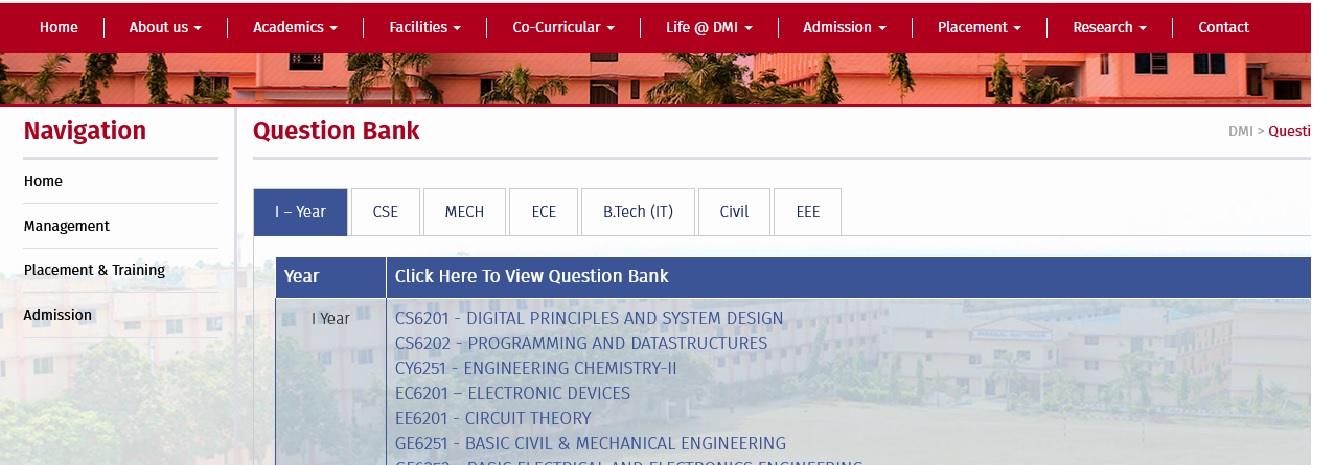CE2302 Structural Analysis Question Bank : dmice.ac.in
Name of the College : DMI College OF Engineering
Subject : STRUCTURAL ANALYSIS – I
Website : dmice.ac.in
Document type : Question Bank
Download Model/Sample Question Paper :
STRUCTURAL ANALYSIS – I : https://www.pdfquestion.in/uploads/dmice.ac.in/225-CE2302.docx
DMI Structural Analysis Question Bank
CE2302 – :
QUESTION BANK :
UNIT – I
DEFLECTION OF DETERMINATE STRUCTURES :
Part A
** Differentiate Perfect frame from deficient frame with an example.
** Determine the free and slope of a cantilever beam having length ‘L’ due to an applied moment, ‘M’ at free and using the principle of virtual work.
Related : DMI College OF Engineering CE2304 Environmental Engineering Question Bank : www.pdfquestion.in/220.html
** State Castigliano’s first theorem.
** How do you find a structure a determinate or indeterminate?
** State the principle of virtual work for deflections.
** State a few applications of Williot diagram.
** Write down the Castigliano’s first theorem.
** State the basic unit load formula.
** Differentiate perfect and imperfect frame.

** Explain the principle of least work.
** State Maxwell?s Reciprocal theorem?
** State the principle of virtual force?
** State the principle of virtual displacement?
** What is the Mohr?s correction?
Differentiate: determinate and indeterminate structures?
** State the principle of virtual work?
** Why it is necessary to compute deflections in structures?
** Name any four methods used for computation of deflection in structures?
** State the difference between strain energy method and unit load method in the determination of deflection of structures?
** What are the assumptions made in the unit load method?
** Give the equation that is used for the determination of deflection at a given point in beams and frames?
Define: Unit load method?
Part B
** Calculate the central deflection and slope at the ends of a simply supported beam carrying UDL of intensity w/m throughout the span. Use Castigliano’s first theorem.
** Determine the deflection at the centre of a simply supported beam carrying a uniformly distributed load of intensity w/m throughout the span [L]. EI is constant. Also determine the incremental deflection at the centre due to an additional point load ‘P’ at the centre. Use principle of virtual work.
(i) What is Williot diagram? Describe its uses and importance.
(ii)Two rods AC and BC are hinged at C and is carrying a load of 80 kN at C as shown in
4. Determine the vertical and horizontal displacement of the joint „B? in a pin jointed frame shown in fig.
5. Determine the deflection at the centre of a simply supported beam carrying a uniformly distributed load of intensity w/m throughout the span [L]. EI is constant. Also determine the incremental deflection at the centre due to an additional point load ‘P’ at the centre. Use principle of virtual work.
6. Calculate the central deflection and slope at the ends of a simply supported beam carrying UDL of intensity w/m throughout the span. Use Castigliano’s first theorem.
7. Using principle of virtual work, find the deflection and slpoe at C for the frame shown in fig. Take= 25000kNm2.
8. Find horizontal deflection at C for the truss shown in Fig. Take, A= 1000mm2, E=200kN/mm2 for all the members
9. Determine the vertical and horizontal displacement of the joint „B? in a pin jointed frame shown in fig.
10. Determine the vertical and horizontal deflection of the point C of the pin jointed plane frame shown in fig.Q.No.1, the cross sectional area of AB is 100 mm² and of AC and BC are 150 mm² each. E = 2×105 N/mm².
11. The members of a Warren type truss are subjected to a change in length in mm as shown in each member shown in fig.Q.No.2 due to certain loading. Draw the Williot Mohr diagram and find the vertical deflection of the joint C.
12. (i) What is Williot diagram? Describe its uses and importance.
(ii)Two rods AC and BC are hinged at C and is carrying a load of 80 kN at C as shown in fig.Q.No.3. Find graphically the vertical and horizontal deflection of the joint C. Take area of member AB as 900 mm² and that of member BC as 1200 mm². Take E = 2.02 x 105 N/mm².
13. Using principle of virtual work, find the deflection and slope at C for the frame shown in fig.Q.No.4. EI = 25000 kNm².
14. Determine the horizontal displacement at the roller support of the rigid jointed frame shown in fig.Q.No.5. Take E = 2 x 105 MPa and I1 = 30 x 108 mm4.
15. Determine the vertical deflection of point C in the truss shown in fig.Q.No.6. The cross sectional area of members AD and DE are 1500 mm² while those of other members are 1000 mm². Take E = 200 GPa.
16. Determine the horizontal and vertical displacement at joint B for the pin jointed frame shown in fig.No.7. The cross sectional area of the members are 1000 mm² and E = 2 x 105 N/mm².